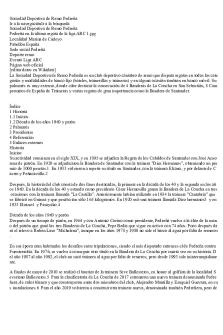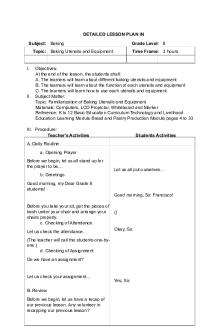Fire Extinguisher - Discrepant Event - Baking Soda and Vinegar - Summary PDF

| Title | Fire Extinguisher - Discrepant Event - Baking Soda and Vinegar - Summary |
|---|---|
| Author | Gwyneth Yvonne Laguros |
| Course | General Chemistry Ii, Laboratory |
| Institution | Ateneo de Manila University |
| Pages | 3 |
| File Size | 96.3 KB |
| File Type | |
| Total Downloads | 11 |
| Total Views | 175 |
Summary
The mixing of baking soda, water, salt, vinegar andsoap will be effective components for an alternativemixtures for a fire extinguisher. The researchers needs toknow if the ingredients of the alternative mixtures arecompatible together and can instantly ...
Description
Glenda Schultz & Brian Lien
Baking soda is another name for the chemical compound sodium bicarbonate. It reacts with any type of acid such as vinegar to form gaseous carbon dioxide (CO2). You can actually see it being produced— it makes the bubbles and foam that you observe when you add the vinegar to the glass dish. The same carbon dioxide reaction makes a baking soda volcano erupt or inflates a balloon when you mix an acid with sodium bicarbonate. In this experiment the CO2 extinguishes the candle flame. Although you can’t see it, the CO2 produced by the baking soda–vinegar reaction starts filling the glass dish from the bottom up. Eventually, once all of the air in the glass dish is replaced by carbon dioxide, the flame has no more oxygen left to burn and it goes out. If you try to light the candle again, it won’t ignite because the match also goes out once it enters the carbon dioxide layer in the glass dish. When you add just water to the baking powder in the glass dish, however, no carbon dioxide is produced because water is not an acid. Therefore, the candle should have kept burning as long as enough oxygen and fuel was available. Fire Extinguisher This discrepant event is intended to show the existence of an invisible substance that puts out a fire. In order for a candle to burn, oxygen (O2) is required. Vinegar mixed with dissolved baking soda causes a quick chemical reaction that creates the product carbon dioxide (CO2). If the chemical reaction occurs inside a beaker containing a lit candle, the carbon dioxide created will accumulate and push out the oxygen, thus extinguishing the flame. Preparation & List of Materials (per table): -1 or 2 medium sized candles -3 different sized beakers (large, medium, small) -Matches -Baking soda
-Oil -Vinegar -Water
Safety Considerations: Working with matches and fire, the experiment should be done in an open environment where flammable items are placed away.
Glenda Schultz & Brian Lien
Instructions: Step 1 -
Using the medium sized beaker, place baking soda and water inside. Place a medium sized candle (one that will fit completely inside the beaker) into the beaker and light. With the lit candle inside, pour the vinegar into the beaker. Baking soda + Vinegar -------- CO2 (GAS)
In order for a candle to burn, oxygen (O2) is required. Vinegar mixed with dissolved baking soda causes a quick chemical reaction that creates the product carbon dioxide (CO2). Materials needed: Clear bottle or any available small container (with a hole punched in the lid)
Vinegar
Baking soda
Candle/s
Matches or lighter
1. Pour the vinegar into the bottle until it is halfway full. 2. Drop a spoonful of baking soda into the glass. If you are using a lid, screw it on. 3. While the mixture bubbles and foams, Lett her eact i oncal m down,whi l eyoul i ghtt he candl e/ swith a match or lighter. 4. Put the container next to the flame. Slowly tilt the container, then pour out the gas, but not the liquid. If using a lid with a hole, aim the hole at the flame. In this experiment, we produced a chemical reaction. We made carbon dioxide, which weighs more than oxygen. Fire needs oxygen and fuel to burn. Thus, taking just one of these things away will make the fire go out. When we placed the carbon dioxide over the flame, the carbon dioxide replaced the oxygen. This caused the fire to die because it was not getting oxygen. Baking soda + Vinegar -------- CO2 (GAS)
Glenda Schultz & Brian Lien...
Similar Free PDFs

Discrepant Event - Marshmallow
- 2 Pages

Vinegar Tom Summary
- 3 Pages

Event
- 4 Pages

Oil and Vinegar Dont Mix
- 8 Pages

Soda PDF-converted-La Profesa
- 4 Pages

Soda PDF-converted-remo pedreña
- 4 Pages
Popular Institutions
- Tinajero National High School - Annex
- Politeknik Caltex Riau
- Yokohama City University
- SGT University
- University of Al-Qadisiyah
- Divine Word College of Vigan
- Techniek College Rotterdam
- Universidade de Santiago
- Universiti Teknologi MARA Cawangan Johor Kampus Pasir Gudang
- Poltekkes Kemenkes Yogyakarta
- Baguio City National High School
- Colegio san marcos
- preparatoria uno
- Centro de Bachillerato Tecnológico Industrial y de Servicios No. 107
- Dalian Maritime University
- Quang Trung Secondary School
- Colegio Tecnológico en Informática
- Corporación Regional de Educación Superior
- Grupo CEDVA
- Dar Al Uloom University
- Centro de Estudios Preuniversitarios de la Universidad Nacional de Ingeniería
- 上智大学
- Aakash International School, Nuna Majara
- San Felipe Neri Catholic School
- Kang Chiao International School - New Taipei City
- Misamis Occidental National High School
- Institución Educativa Escuela Normal Juan Ladrilleros
- Kolehiyo ng Pantukan
- Batanes State College
- Instituto Continental
- Sekolah Menengah Kejuruan Kesehatan Kaltara (Tarakan)
- Colegio de La Inmaculada Concepcion - Cebu









